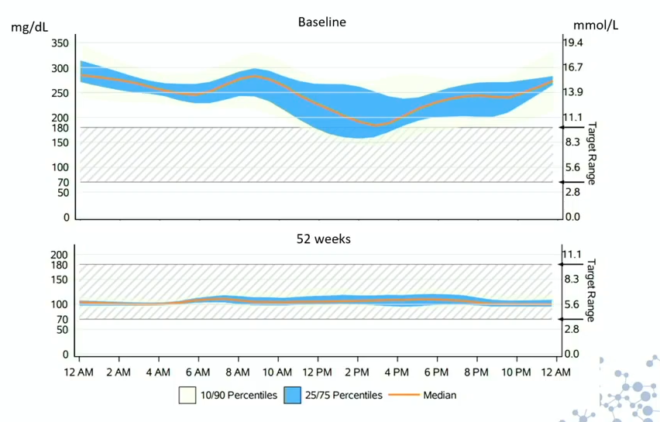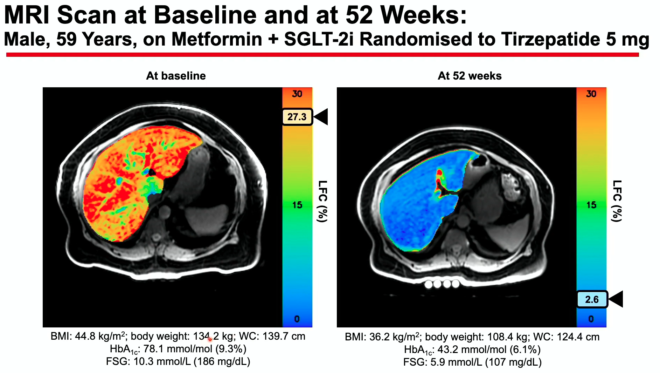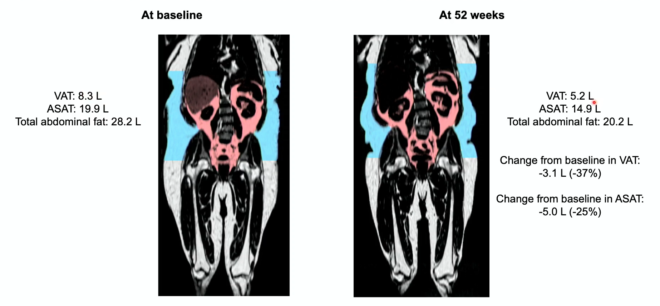Mounjaro Shows Multiple Benefits for Type 2 Diabetes Management
During the 2022 Advanced Technologies and Treatments for Diabetes Conference (ATTD), researchers shared promising data for a new medication specifically aimed at improving glycemic control in adults with type 2 diabetes. Lilly’s Mounjaro, also known as tirzepatide, just received FDA approval, making it the first introduced medication for type 2 diabetes in nearly a decade.
What is Mounjaro (tirzepatide)?
Mounjaro is a new once-weekly injection used in conjunction with diet and exercise to improve blood glucose control in adults with type 2 diabetes. It is a glucose-dependent insulinotropic polypeptide (GIP) and glucagon-like peptide-1 (GLP-1) receptor agonist. This dual agonist has shown powerful impacts on several aspects of diabetes management.
It will be available in six doses ranging from 2.5mg to 15mg and delivered via an injector pen with a pre-hidden needle, helping reduce management barriers like fear of injections.
What results are seen with Mounjaro?
As previously reported, Mounjaro helped adults living with obesity lose approximately 22.5 percent of their body weight in the 72-week clinical trial. However, the benefits do not stop at weight loss.
Overall reduction in numbers
Dr. Tadaj Battelino from the University of Ljubljana reported at ATTD that adults with type 2 diabetes on metformin in conjunction with Mounjaro resulted in 25 percent higher time in tight target range (TITR) shown at 24 weeks and continued until 52 weeks.
In a patient example, Dr. Battelino showed the several benefits of Mounjaro in addition to TITR. The example patient, an adult male taking 5mg of Mounjaro (tirzepatide), showed a 3.6 percent decrease in A1c, approximately 17 pound (23.8kg) weight loss and lowered body mass index (BMI) since the beginning of the study (baseline).

Better glycemic control
Data on Mounjaro also showed impacts on blood glucose control via continuous glucose monitor data (CGM), according to Dr. Battelino. Mounjaro not only helped lower blood glucose levels into the target range (shaded area), but it also reduced the variability of spikes, as shown by the straighter line after 52 weeks in the graph below.
 “So critical in type 2 [diabetes], not as a continuous [glucose] measure but as an interim measure to whether a therapy is sufficient for the individual,” Dr. Battelino said on the importance of CGM for type 2 diabetes management.
“So critical in type 2 [diabetes], not as a continuous [glucose] measure but as an interim measure to whether a therapy is sufficient for the individual,” Dr. Battelino said on the importance of CGM for type 2 diabetes management.
Lower fat content
Dr. Amalia Gastaldelli from the Cardiometabolic Risk Lab at the University of Texas Health San Antonio presented SURPASS-3 results on the Mounjaro actions on fat accumulation.
Adults with type 2 diabetes have a higher risk of developing non-alcholic fatty liver disease and increased risk of cardiovascular disease. The aim of the SURPASS-3 substudy was to compare dose effects of Mounjaro to that of insulin at 52 weeks on liver and abdominal fat, Dr. Gastaldelli explained
Medical imaging, like in the MRI below, showed a significant drop in liver fat content (LFC) in adults on Mounjaro, dropping on average around 8 percent LFC from the beginning of the clinical trial. Dr. Gastaldelli showed the patient below who dropped almost 25 percent LFC.
 The benefits of Mounjaro were also shown on adipose tissue. One adult on Mounjaro showed up to a 37 percent decrease in visceral adipose fat (VAT), which is fat stored around the organs, and a 25 percent reduction in abdominal subcutaneous adipose tissue (ASAT), fat under the skin stored in the abdomen area, since the beginning of the 52 week clinical trial.
The benefits of Mounjaro were also shown on adipose tissue. One adult on Mounjaro showed up to a 37 percent decrease in visceral adipose fat (VAT), which is fat stored around the organs, and a 25 percent reduction in abdominal subcutaneous adipose tissue (ASAT), fat under the skin stored in the abdomen area, since the beginning of the 52 week clinical trial.

Overall, the results of the SURPASS-3 substudy showed a positive correlation with change in baseline LFC and changes in A1c, body weight, VAT and ASAT.
Improved quality of life
Dr. Battelino also provided data on patients’ ability to perform physical activities of daily life. Patients on Mounjaro showed significantly greater improvement to:
- Get up from the ground
- Get down to the ground
- Standing
- Climbing stairs
- Chores/yard work
- Moderate physical activity
- Strenuous physical activity
Adults on Mounjaro showed overall greater satisfaction with their treatment, improving their quality of life.
How does Mounjaro work?
The benefits of Mounjaro have been astounding, but how does it help people with type 2 diabetes get these results? Dr. Andrea Mari from the Institute of Neuroscience at the National Research Council presented on the mechanisms of action of Mounjaro at ATTD.
Mounjaro affects beta and alpha cells in the pancreas as a dual GIP and GLP-1 receptor agonist. Beta cells release the hormone insulin in response to high blood glucose levels and alpha cells release glucagon in response to low blood glucose levels. Mounjaro is a single molecule that activates both GIP and GLP-1, natural protein hormones that regulate both beta and alpha cells.
In a 28 week clinical trial Mounjaro increased insulin sensitivity and secretion while decreasing levels of glucagon. The result showed Mounjaro helped lower post-meal blood glucose levels.
“The known effects of GLP-1R agonism on beta cell function and weight loss/insulin sensitivity are greatly potentiated with Mounjaro (trizepatide), which can largely reverse the main metabolic defects underlying type 2 diabetes” Dr. Mari stated.
Find more on our coverage of Mounjaro here.





